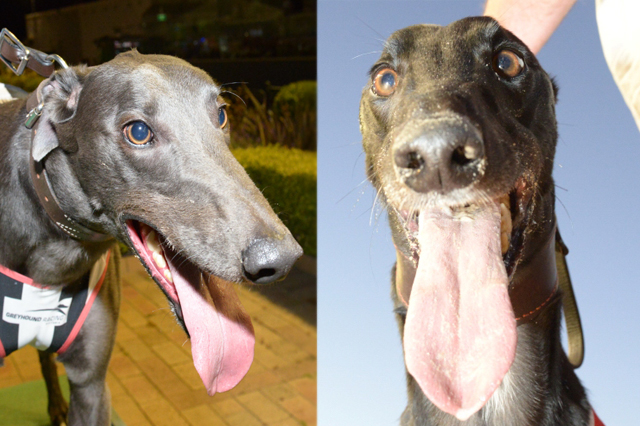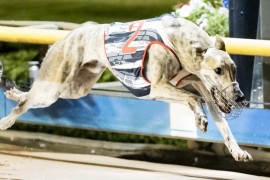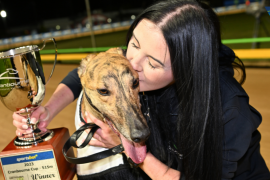A Brief History of the Greyhound!
No one knows exactly when greyhounds came into the lives of humans. At some point after the retreat of the last glaciers people discovered the advantages of dogs as hunting partners — fast, agile, strong dogs who could run down prey that left clumsy humans far behind. Through subsequent millennia they kept those useful dogs close to them, and at some point they learned to breed them selectively, developing a lean, graceful, swift dog of a sight hound type. Such dogs were bred by Bedouin tribes in North Africa and Asia several thousand years ago and were probably the ancestors of modern sight hounds. Dogs that resemble greyhounds decorate a funerary vase from what is now Iran that is over 6,000 years old.
Traditionally, it has been believed that greyhounds are direct descendants of these early sight hounds. This claim is disputed, however, by a 2004 DNA study which indicated that modern greyhounds are not closely related to ancient breeds like the Saluki, but are instead more closely related to European herding dogs like the Irish wolfhound and Saint Bernard.
Dogs that closely resembled greyhounds were the favourites of Egyptian Pharaohs. They were valued so highly that the birth of a greyhound was celebrated almost as much as the birth of a son, and death was mourned with elaborate ceremony. The Egyptians kept many kinds of dogs, but sight hounds were prized as royalty among canines, living with their families or housed in special kennels and cared for by special handlers. They were used in recreational hunts, similar to modern coursing. When a member of the Egyptian nobility died his sight hounds were often buried beside him, while on the walls of the tomb both dogs and men were portrayed pursuing the gazelle into eternity. Anubis, the Egyptian god who helped judge the souls of the dead and guided deserving souls to the underworld, was pictured as having the body of a man and the head of a jackal or a greyhound-like dog.
Over the centuries sight hounds spread throughout the trade routes of the Mediterranean and the Middle East. When the Greeks rose to dominance around 500 B.C. sight hounds rose with them, valued as they had been in Egypt. Images of sight hounds decorate attic vases as they had decorated Egyptian tombs.
Sight hounds appear in Greek mythology as companions of Hecate, goddess of the earth and Hades; Pollex, immortal brother of Helen; and Artemis, goddess of the hunt. A particularly violent story features the sight hounds of Act aeon, a young man who accidentally comes upon Artemis bathing in a forest pool. The outraged goddess changes Act aeon into a stag, who is then pursued and torn apart by his own dogs. At the annual feast of Artemis, hunting hounds partook of the roasted meats with their masters and were honoured by being decked with flowers.
Perhaps the most famous of all Greek dogs is the first of many dogs in literature to represent fidelity unto death. When Homer’s Odysseus returns home in disguise after twenty years of wandering, his old dog Argus raises his head wearily, wags his tail once in recognition and dies. Argus is described as a hunting dog, fierce, swift and fearless — the greyhound as the Greeks knew it.
Judging by the Bible, the ancient Hebrews had not much use for dogs; and though Proverbs 30:29-31 (King James version) is sometimes cited as praising the beauty of the greyhound, the translation of the Hebrew word is open to question. In Islam dogs are avoided as unclean. (The desert Arabs do not regard their Salukis as dogs. The word “Saluki” in Arabic means “hound” or “greyhound”). But the Romans knew a good dog when they saw one and treated their sight hounds even better than the Greeks had, feeding them regular meals instead of throwing them the odd bone. In Roman art Diana, who succeeded the Greek Artemis, is almost always portrayed accompanied by her sight hounds.
The Romans may have been the first to perfect the sport of coursing, matching their sight hounds against the speed and agility of the hare. They carried their dogs into the farthest reaches of their empire, incidentally importing European hares into Britain for their superior coursing qualities. When the empire fell, both the hares and the dogs were left behind.
The period of famine and war that began the Middle Ages was a bad time for dogs and animals generally. Abandoned dogs starved with the rest, but those who were lucky enough to belong to the local clergy or nobility survived. As feudal barons extended their hunting grounds through conquest and expropriation, the demand for dogs was maintained. The clergy, being mostly aristocrats themselves, kept and bred dogs for profit and for their own enjoyment. (They enjoyed them so much that in France in the sixth century laws were proclaimed making it a crime for the clergy to keep hawks and hounds). In the eleventh century King Canute, who briefly maintained Danish rule over England, established the first English Forest Laws, making it a crime for any “mean person” to own a greyhound. Any large dog owned by a peasant was mutilated to prevent him from hunting in the preserves of the nobility. William the Conqueror upheld and strengthened the laws, while the tenth-century Welsh King Hywel Dda made killing a greyhound punishable by death.
Greyhounds disappear from art in these centuries — indeed, art itself almost disappears. But greyhound-like dogs appear in a hunting scene in the Bayeux tapestry (shown at right), while in Ireland the Celts, who had been breeding sight hounds for centuries before their migration to Ireland, preserved their own tradition. Medieval Irish monks included sight hounds in the illuminations of the world’s most beautiful manuscripts.
The first reference to greyhounds in English literature is in The Canterbury Tales, dating from the late fourteenth century. Chaucer’s monk in “The Monk’s Tale” is a plump, well-born prelate who likes his swans well roasted and sees no reason for a holy man to forego the pleasures of the hunt. “Greyhounds he hade as swift as fowl in flight,” as well as “full many a denote hors…in stable.” How these dogs, which were and are any colour but grey, came to be called “greyhounds” is a mystery. There are various theories about the roots of the term. What is clear is that by the early Renaissance this particular breed of sight hound had acquired the modern name of greyhound.
Greyhounds figure prominently in the works of Renaissance artists, as classical subjects became popular and the wealthy aspired to being portrayed with the dogs of royalty. Gentlemen had themselves portrayed in a wood, attended by greyhounds and spaniels and surrounded by heaps of dead rabbits and birds. Ladies became Diana’s, more or less clothed as conscience dictated.
During the reign of Queen Elizabeth greyhounds were used for coursing deer, foxes and hares. The Queen, particularly keen on the coursing of hares, assigned the Duke of Norfolk to draw up rules for coursing that restricted the number of dogs per hare to two and gave the hare a fair start. The sport gained in popularity and eventually became democratized as the middle classes began to acquire dogs and the amount of open land increased. In 1776 Horace Walpole, the Earl of Orford, organized the first public coursing club in England. Orford, who was otherwise quite mad, kept a kennel of 100 greyhounds and experimented with improving the line through out crossing with other breeds. Fortunately no trace remains of his most famous crossbreed, the greyhound-bulldog.
The first greyhounds in the New World were attack dogs used as weapons. Fierce greyhounds and mastiffs were imported by Columbus and the early conquistadors to subdue the indigenous peoples of the Americas, and often simply to torment them for sport. English settlers in North America did not import greyhounds for some time, both because the Forest Laws were in effect until 1700 and because there was neither the terrain nor the leisure for coursing. In the nineteenth century settlers in the Midwest began to import large numbers of greyhounds to control jackrabbits and coyotes, and the Midwest became the coursing centre of the nation.
In the 1930s American greyhound racing became hugely popular as tracks proliferated around the country. Increasingly large amounts of money were invested, inevitably attracting corruption and organized crime. Regulatory boards were established in the UK and the US to register racing dogs and oversee the sport. In the US, all racing greyhounds are registered with the National Greyhound Association; show greyhounds are registered with the American Kennel Club.
As a breed greyhounds are gentle and affectionate and remarkably calm in temperament!
Heidi G. Parker, Lisa V. Kim, Nathan B. Sutter, Scott Carlson, Travis D. Lorentzen, Tiffany B. Malek, Gary S. Johnson, Hawkins B. DeFrance, Elaine A. Ostrander,
Leonid Kruglyak, Genetic Structure of the Purebred Domestic Dog, Science Magazine, May 21, 2004.
For more information, please consult their web site at www.grey2kusaedu.org.





